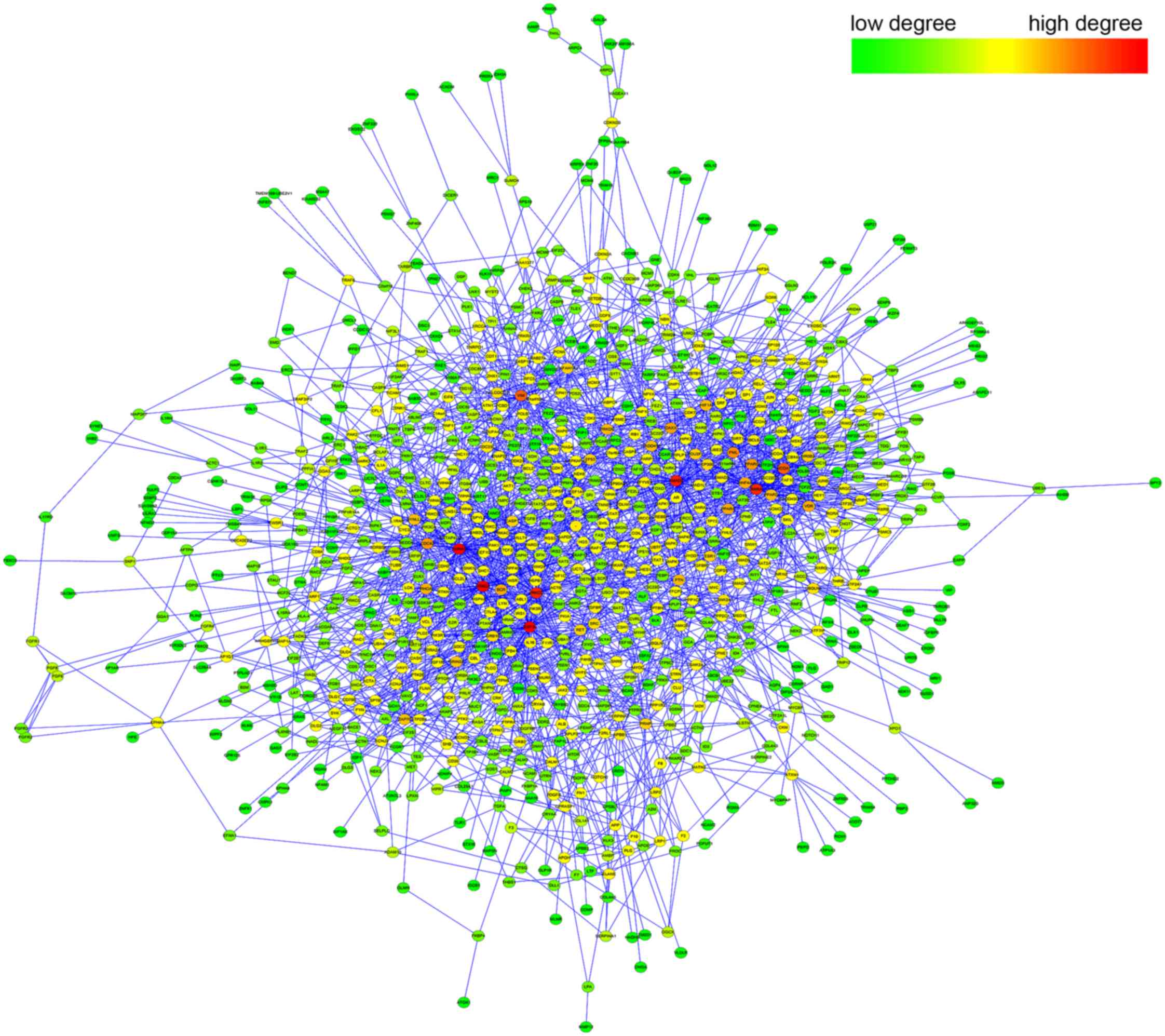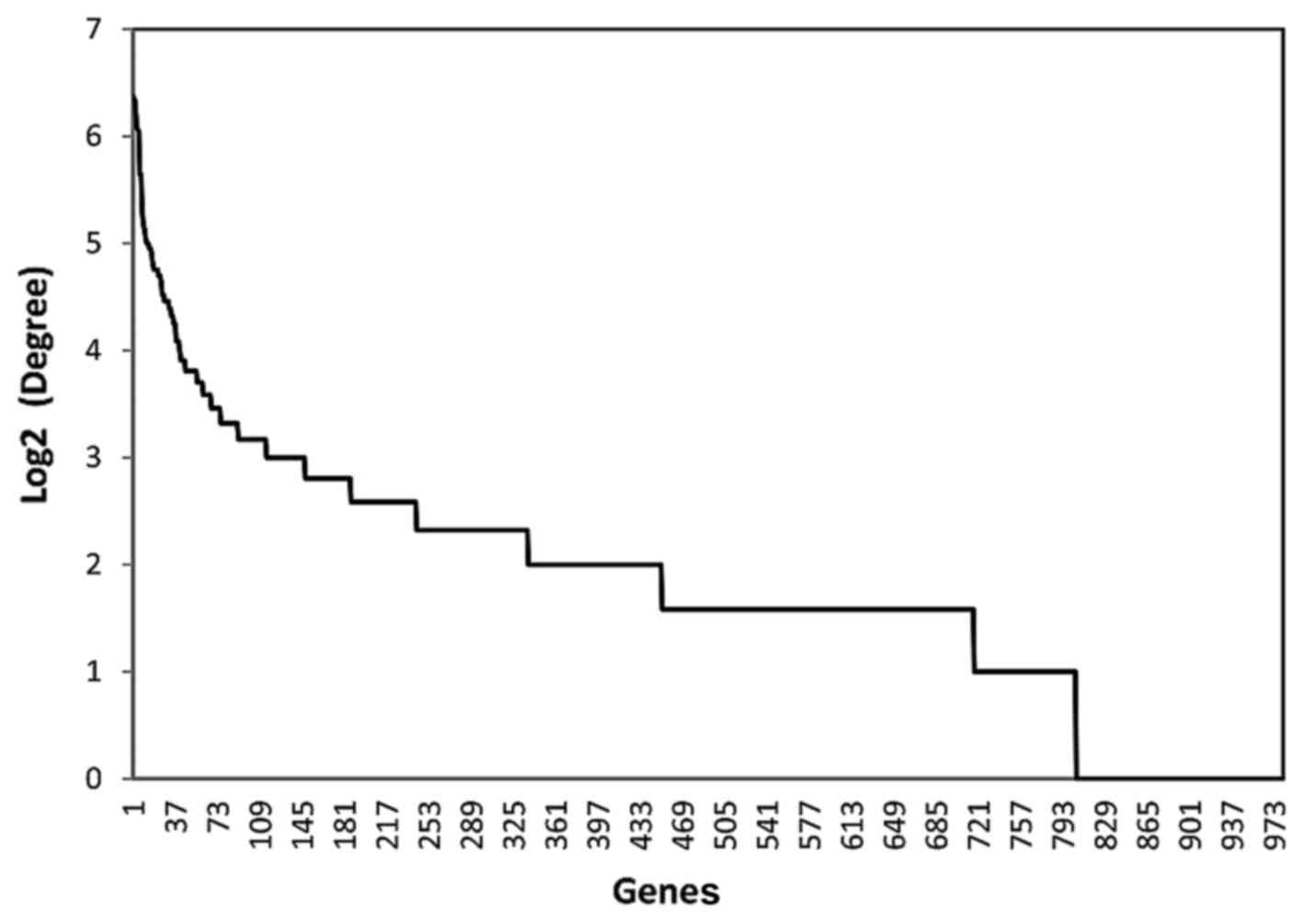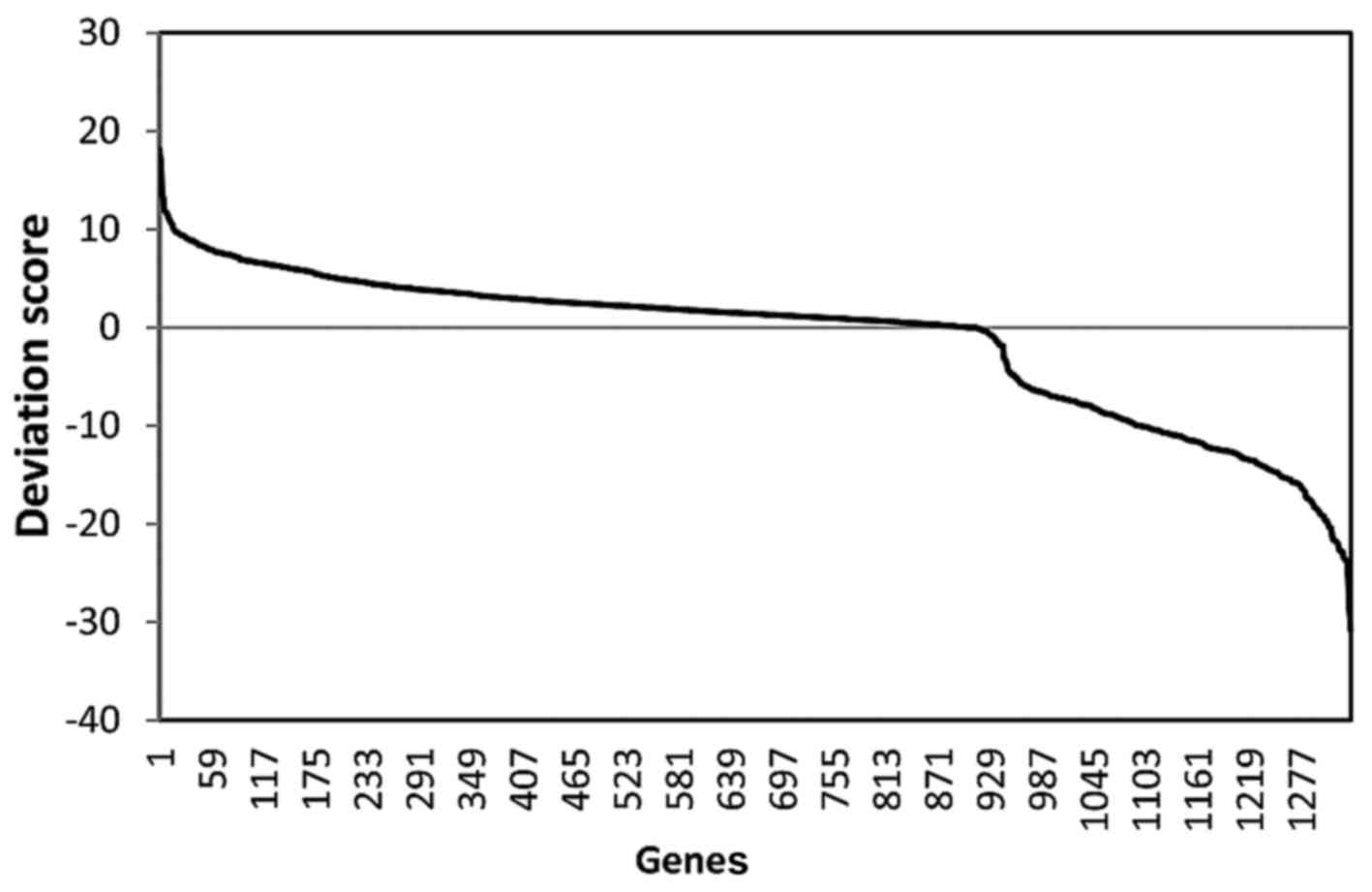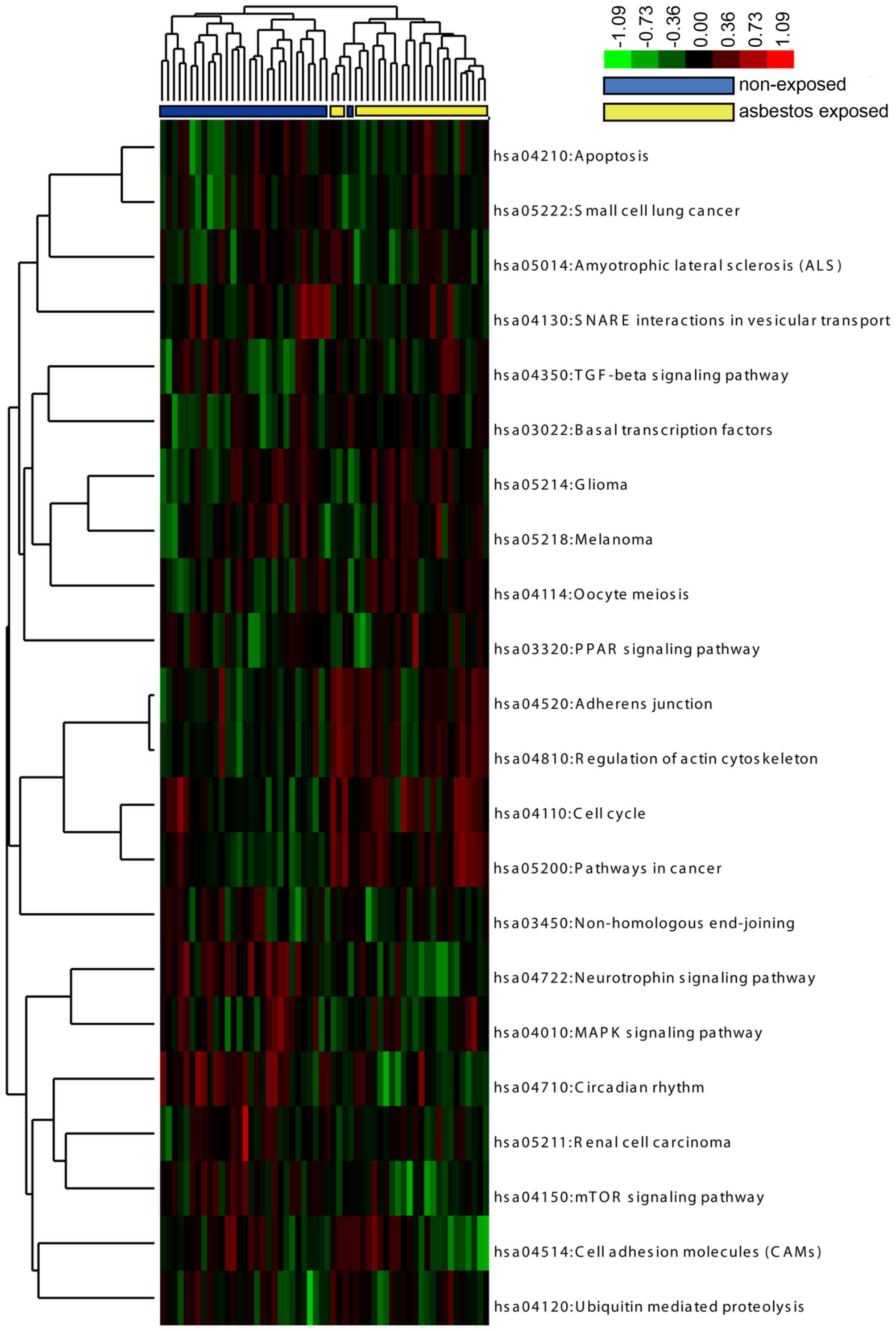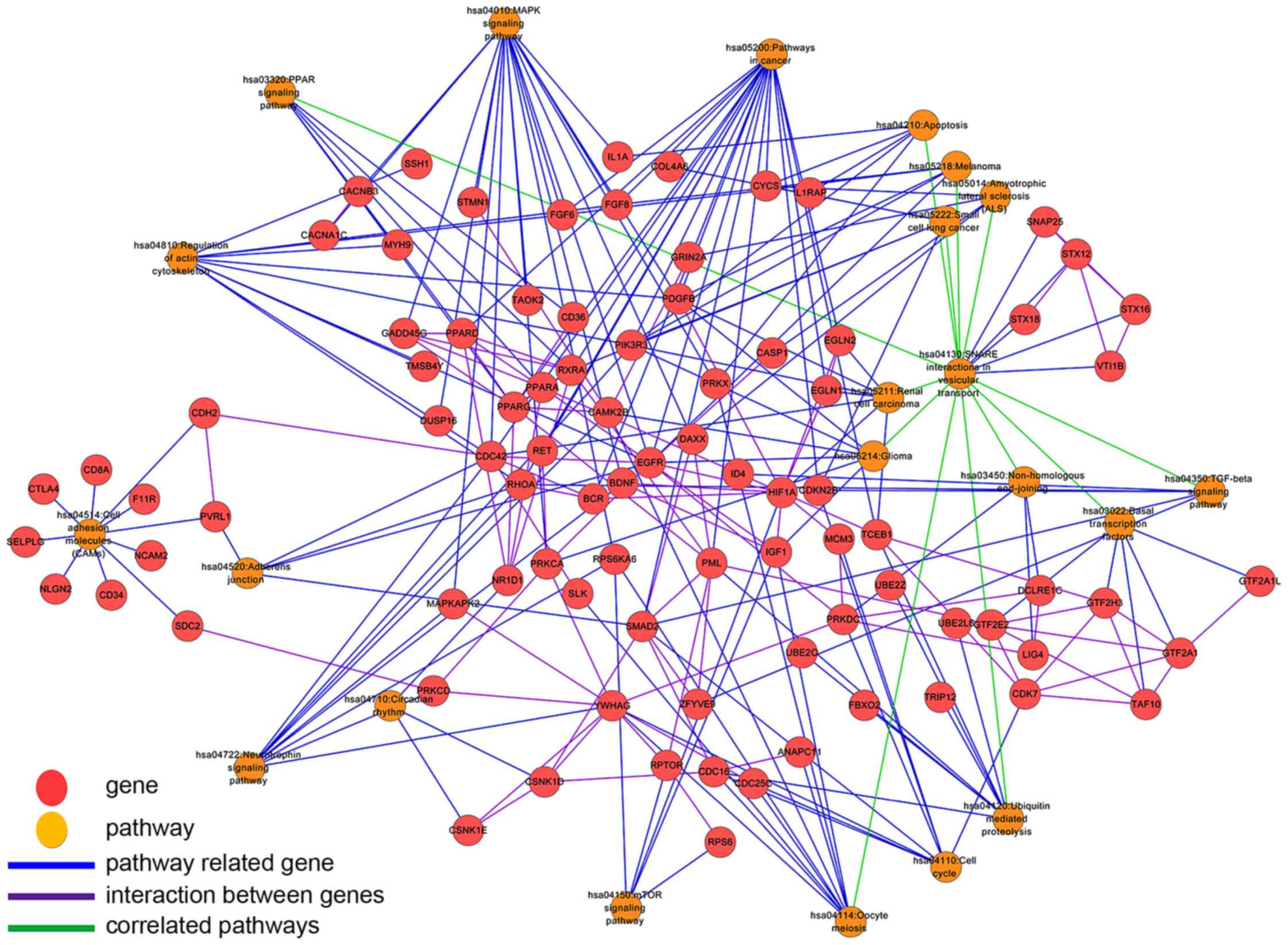|
1
|
Ferlay J, Soerjomataram I, Ervik M,
Dikshit R, Eser S, Mathers C, Rebelo M, Parkin DM, Forman D and
Bray F: GLOBOCAN 2012 v1.0, Cancer Incidence and Mortality
Worldwide: IARC CancerBase No. 11 (Internet). International Agency
for Research on Cancer; Lyon, France: 2013, Available from:
http://globocan.iarc.fr.2014.
|
|
2
|
Balgkouranidou I, Liloglou T and Lianidou
ES: Lung cancer epigenetics: Emerging biomarkers. Biomarkers Med.
7:49–58. 2013. View Article : Google Scholar
|
|
3
|
LaDou J: The asbestos cancer epidemic.
Environ Health Perspect. 112:285–290. 2004. View Article : Google Scholar : PubMed/NCBI
|
|
4
|
Nymark P, Guled M, Borze I, Faisal A,
Lahti L, Salmenkivi K, Kettunen E, Anttila S and Knuutila S:
Integrative analysis of microRNA, mRNA and aCGH data reveals
asbestos- and histology-related changes in lung cancer. Genes
Chromosomes Cancer. 50:585–597. 2011. View Article : Google Scholar : PubMed/NCBI
|
|
5
|
Lin RT, Takahashi K, Karjalainen A,
Hoshuyama T, Wilson D, Kameda T, Chan CC, Wen CP, Furuya S, Higashi
T, et al: Ecological association between asbestos-related diseases
and historical asbestos consumption: An international analysis.
Lancet. 369:844–849. 2007. View Article : Google Scholar : PubMed/NCBI
|
|
6
|
Xu X, Li X, Cheng J, Liu Z, Thrall M, Wang
X, Wang X and Wong S: Quantitative label-free multimodality
nonlinear optical imaging for in situ differentiation of cancerous
lesions. Proc SPIE 8565; March 8 2013; Photonic Therapeutics and
Diagnostics; IX:pp. 85653A2013, View Article : Google Scholar : http://dx.doi.org/10.1117/12.2002633.
|
|
7
|
Henschke CI; International Early Lung
Cancer Action Program Investigators: Survival of patients with
clinical stage I lung cancer diagnosed by computed tomography
screening for lung cancer. Clin Cancer Res. 13:4949–4950. 2007.
View Article : Google Scholar : PubMed/NCBI
|
|
8
|
Henschke CI, Yankelevitz DF, Libby DM,
Pasmantier MW, Smith JP and Miettinen OS; International Early Lung
Cancer Action Program Investigators: Survival of patients with
stage I lung cancer detected on CT screening. N Engl J Med.
355:1763–1771. 2006. View Article : Google Scholar : PubMed/NCBI
|
|
9
|
Schwartz AG, Prysak GM, Bock CH and Cote
ML: The molecular epidemiology of lung cancer. Carcinogenesis.
28:507–518. 2007. View Article : Google Scholar
|
|
10
|
Wright CM, Savarimuthu Francis SM, Tan ME,
Martins MU, Winterford C, Davidson MR, Duhig EE, Clarke BE, Hayward
NK, Yang IA, et al: MS4A1 dysregulation in asbestos-related lung
squamous cell carcinoma is due to CD20 stromal lymphocyte
expression. PLoS One. 7:e349432012. View Article : Google Scholar : PubMed/NCBI
|
|
11
|
Wikman H, Ruosaari S, Nymark P, Sarhadi
VK, Saharinen J, Vanhala E, Karjalainen A, Hollmén J, Knuutila S
and Anttila S: Gene expression and copy number profiling suggests
the importance of allelic imbalance in 19p in asbestos-associated
lung cancer. Oncogene. 26:4730–4737. 2007. View Article : Google Scholar : PubMed/NCBI
|
|
12
|
Nymark P, Lindholm PM, Korpela MV, Lahti
L, Ruosaari S, Kaski S, Hollmén J, Anttila S, Kinnula VL and
Knuutila S: Gene expression profiles in asbestos-exposed epithelial
and mesothelial lung cell lines. BMC Genomics. 8:622007. View Article : Google Scholar : PubMed/NCBI
|
|
13
|
Nymark P, Wikman H, Hienonen-Kempas T and
Anttila S: Molecular and genetic changes in asbestos-related lung
cancer. Cancer Lett. 265:1–15. 2008. View Article : Google Scholar : PubMed/NCBI
|
|
14
|
Ruosaari S, Hienonen-Kempas T, Puustinen
A, Sarhadi VK, Hollmén J, Knuutila S, Saharinen J, Wikman H and
Anttila S: Pathways affected by asbestos exposure in normal and
tumour tissue of lung cancer patients. BMC Med Genomics. 1:552008.
View Article : Google Scholar : PubMed/NCBI
|
|
15
|
Wright CM, Larsen JE, Hayward NK, Martins
MU, Tan ME, Davidson MR, Savarimuthu SM, McLachlan RE, Passmore LH,
Windsor MN, et al: ADAM28: A potential oncogene involved in
asbestos-related lung adenocarcinomas. Genes Chromosomes Cancer.
49:688–698. 2010. View Article : Google Scholar : PubMed/NCBI
|
|
16
|
Smyth GK: Limma: Linear models for
microarray data. Bioinformatics and Computational Biology Solutions
Using R and Bioconductor. Springer; pp. 397–420. 2005, http://link.springer.com/chapter/10.1007%2F0-387-29362-0_23#page-1.
View Article : Google Scholar
|
|
17
|
Chatr-Aryamontri A, Breitkreutz B-J,
Heinicke S, Boucher L, Winter A, Stark C, Nixon J, Ramage L, Kolas
N, O'Donnell L, et al: The BioGRID interaction database: 2013
update. Nucleic Acids Res. 41:D816–D823. 2013. View Article : Google Scholar :
|
|
18
|
Keshava Prasad TS, Goel R, Kandasamy K,
Keerthikumar S, Kumar S, Mathivanan S, Telikicherla D, Raju R,
Shafreen B, Venugopal A, et al: Human protein reference
database-2009 update. Nucleic Acids Res. 37:D767–D772. 2009.
View Article : Google Scholar
|
|
19
|
Saito R, Smoot ME, Ono K, Ruscheinski J,
Wang PL, Lotia S, Pico AR, Bader GD and Ideker T: A travel guide to
Cytoscape plugins. Nat Methods. 9:1069–1076. 2012. View Article : Google Scholar : PubMed/NCBI
|
|
20
|
Doncheva NT, Assenov Y, Domingues FS and
Albrecht M: Topological analysis and interactive visualization of
biological networks and protein structures. Nat Protoc. 7:670–685.
2012. View Article : Google Scholar : PubMed/NCBI
|
|
21
|
Kanehisa M, Goto S, Sato Y, Kawashima M,
Furumichi M and Tanabe M: Data, information, knowledge and
principle: Back to metabolism in KEGG. Nucleic Acids Res.
42:D199–D205. 2014. View Article : Google Scholar :
|
|
22
|
Huang W, Sherman BT and Lempicki RA:
Systematic and integrative analysis of large gene lists using DAVID
bioinformatics resources. Nat Protoc. 4:44–57. 2009. View Article : Google Scholar
|
|
23
|
de Hoon MJ, Imoto S, Nolan J and Miyano S:
Open source clustering software. Bioinformatics. 20:1453–1454.
2004. View Article : Google Scholar : PubMed/NCBI
|
|
24
|
Saldanha AJ: Java Treeview - extensible
visualization of microarray data. Bioinformatics. 20:3246–3248.
2004. View Article : Google Scholar : PubMed/NCBI
|
|
25
|
EL Andaloussi S, Mäger I, Breakefield XO
and Wood MJ: Extracellular vesicles: Biology and emerging
therapeutic opportunities. Nat Rev Drug Discov. 12:347–357. 2013.
View Article : Google Scholar : PubMed/NCBI
|
|
26
|
Vinciguerra P and Stutz F: mRNA export: An
assembly line from genes to nuclear pores. Curr Opin Cell Biol.
16:285–292. 2004. View Article : Google Scholar : PubMed/NCBI
|
|
27
|
Schorey JS and Bhatnagar S: Exosome
function: From tumor immunology to pathogen biology. Traffic.
9:871–881. 2008. View Article : Google Scholar : PubMed/NCBI
|
|
28
|
Staals RH and Pruijn GJ: The human exosome
and disease. RNA Exosome. Springer; pp. 132–142. 2010, http://link.springer.com/chapter/10.1007%2F978-1-4419-7841-7_11#page-1.
View Article : Google Scholar
|
|
29
|
Azmi AS, Bao B and Sarkar FH: Exosomes in
cancer development, metastasis, and drug resistance: A
comprehensive review. Cancer Metastasis Rev. 32:623–642. 2013.
View Article : Google Scholar : PubMed/NCBI
|
|
30
|
Reymond N, Im JH, Garg R, Vega FM, Borda
d'Agua B, Riou P, Cox S, Valderrama F, Muschel RJ and Ridley AJ:
Cdc42 promotes transendothelial migration of cancer cells through
β1 integrin. J Cell Biol. 199:653–668. 2012. View Article : Google Scholar : PubMed/NCBI
|
|
31
|
Lee SH and Dominguez R: Regulation of
actin cytoskeleton dynamics in cells. Mol Cells. 29:311–325. 2010.
View Article : Google Scholar : PubMed/NCBI
|
|
32
|
Boardman KC, Aryal AM, Miller WM and
Waters CM: Actin re-distribution in response to hydrogen peroxide
in airway epithelial cells. J Cell Physiol. 199:57–66. 2004.
View Article : Google Scholar : PubMed/NCBI
|
|
33
|
Li J, Poovey HG, Rodriguez JF, Brody A and
Hoyle GW: Effect of platelet-derived growth factor on the
development and persistence of asbestos-induced fibroproliferative
lung disease. J Environ Pathol Toxicol Oncol. 23:253–266. 2004.
View Article : Google Scholar : PubMed/NCBI
|
|
34
|
Sabourin LA, Tamai K, Seale P, Wagner J
and Rudnicki MA: Caspase 3 cleavage of the Ste20-related kinase SLK
releases and activates an apoptosis-inducing kinase domain and an
actin-disassembling region. Mol Cell Biol. 20:684–696. 2000.
View Article : Google Scholar
|
|
35
|
Brody AR: Asbestos-induced lung disease.
Environ Health Perspect. 100:21–30. 1993. View Article : Google Scholar : PubMed/NCBI
|
|
36
|
Shukla A, Lounsbury KM, Barrett TF, Gell
J, Rincon M, Butnor KJ, Taatjes DJ, Davis GS, Vacek P, Nakayama KI,
et al: Asbestos-induced peribronchiolar cell proliferation and
cytokine production are attenuated in lungs of protein kinase C-δ
knockout mice. Am J Pathol. 170:140–151. 2007. View Article : Google Scholar : PubMed/NCBI
|
|
37
|
Shukla A, Barrett TF, Nakayama KI,
Nakayama K, Mossman BT and Lounsbury KM: Transcriptional
upregulation of MMP12 and MMP13 by asbestos occurs via a
PKCdelta-dependent pathway in murine lung. FASEB J. 20:997–999.
2006. View Article : Google Scholar : PubMed/NCBI
|















